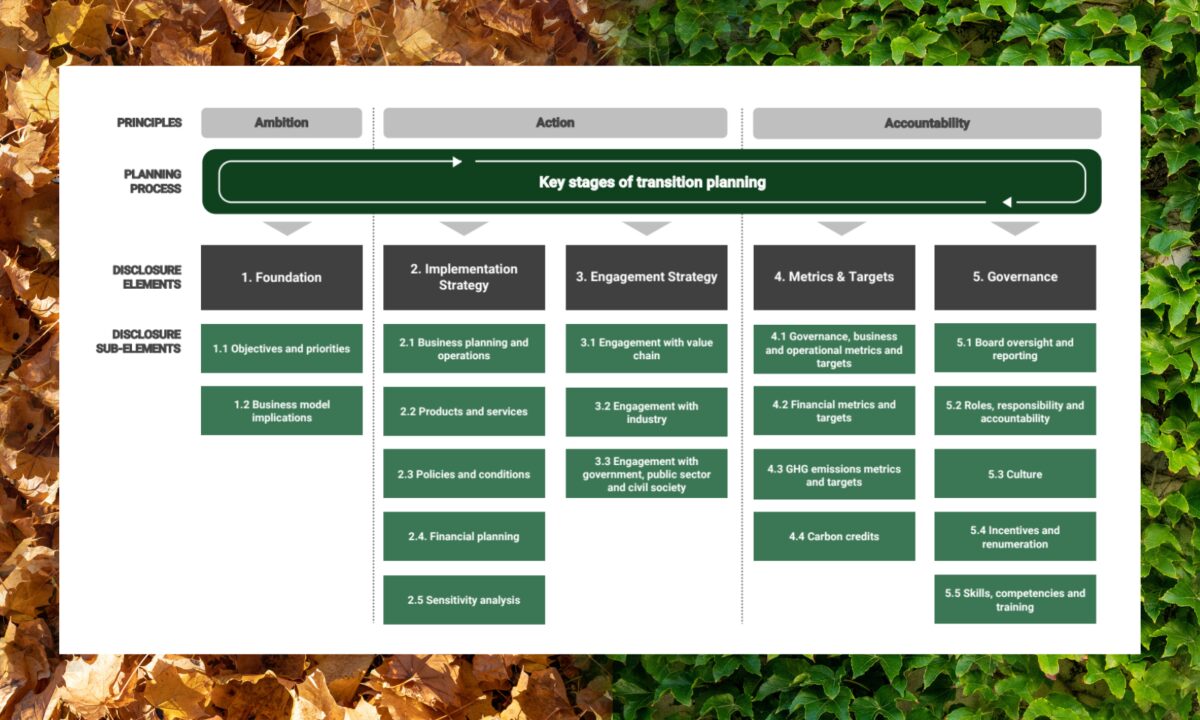TCFD reporting requirements in the UK: climate transition plans explained
More and more businesses are measuring their carbon footprint and setting a net-zero target in line with science-based trajectories – typically to achieve a 50% reduction in carbon emissions by 2030, and net-zero by 2050. However, as 2030 looms closer, many businesses are realising that they have no idea how they will achieve these targets. So, what’s the next step?
Businesses serious about reaching net zero need a clear strategy setting out how they’ll achieve their climate ambitions, and address the risks and opportunities posed by climate change. This is where a transition plan comes in.
Research undertaken by the Carbon Disclosure Project (CDP) found that while 80% of UK-listed firms say they are committed to net zero by 2050, just 5% have published detailed, actionable climate transition plans. This indicates a big disparity between ambition and action when it comes to corporate sustainability. Clearly, there is a lot more work to do to establish how net-zero goals will be met.
The context

From January 2022, the Financial Conduct Authority (FCA) mandated that UK financial institutions and listed companies publish climate-related disclosures through the Task Force on Climate-related Financial Disclosure (TCFD).
In April 2022, HM Treasury launched the Transition Plan Taskforce (TPT) with the aim of developing a gold standard for corporate climate transition plans as part of a wider initiative to establish the UK as a net-zero-aligned financial centre. Reporting requirements will become increasingly stringent, with the FCA committing to consult in the first half of 2024 on mandatory sustainability disclosures for listed companies, likely including transition plan disclosure requirements. It is possible that these requirements will extend beyond listed entities - the Government has committed to consult on mandatory transition plan disclosures for large companies in winter 2023.
Following almost a year of consultation, the TPT published its final Disclosure Framework and Implementation Guidance in October 2023. Sector-specific guidance is being developed and will be published in early 2024. While the legislation to mandate the publication of transition plans is pending, the TPT has urged companies to get ahead and demonstrate that their climate commitments are backed up by action.
What is the TCFD?
Established by the Financial Stability Board (FSB), the TCFD was tasked to help companies make their climate-related disclosures more consistent. It developed recommendations on the types of information that companies should disclose to support investors, lenders, and insurance underwriters in appropriately assessing and pricing current and future climate-related risks. These recommendations are categorised under four main pillars – governance, strategy, risk management, and metrics and targets – which form the TCFD framework. This supports companies in developing more effective climate transition plans and understand how those plans align with the TCFD framework of recommendations.
What is a climate transition plan?

A transition plan sets out the short, medium and long-term actions that will enable an organisation to meet its long-term carbon reduction targets. The plan should also describe the metrics and targets a business will use to assess the progress of its plan, and the governance mechanisms that will oversee its delivery.
The TPT’s framework sets out three guiding principles which are the foundation for developing a transition plan:
- Ambition: “contribute to and prepare for a rapid and orderly economy-wide net zero transition”,
- Action: “focus on concrete actions which emphasise the short-term and strive for resilience”,
- Accountability: “enable delivery of the plan through clear governance mechanisms along with consistent, comparable and decision-useful reporting and verification”.
Within these principles sit five disclosure elements and a further 19 disclosure sub-elements, designed to guide companies through the process of developing a thorough and credible transition plan.
While decarbonisation is a fundamental aspect of a transition plan, the plan should go beyond the parameters of a carbon reduction plan. The TPT strongly emphasises that every company’s transition plan should contribute towards an economy-wide transition. This means that companies should consider the full range of levers at their disposal to affect change at a broader level. This could include engaging with suppliers, collaborating with industry peers, or lobbying government to influence the policy landscape.
The TPT recommends producing a transition plan as a stand-alone document every three years, but with reporting and disclosure in the meantime, for example through CDP.
What makes a credible climate transition plan?

Of 1,448 UK organizations disclosing through CDP's climate change questionnaire in 2022, 404 claimed they had developed a low-carbon transition plan. Of these, just six disclosed against each of the CDP’s 21 key indicators that denote a credible climate transition plan.
Businesses without a transition plan to back up their climate ambitions are at risk of accusations of greenwashing – a recent report from LSE found that one of the most common causes of legal action was where corporate climate commitments were not backed up by adequate plans and policies.
The main purpose of the TPT framework is to establish common standards that enable businesses to develop robust and credible transition plans. The framework aims to provide specificity and granularity on what UK transition plans should include:
- Embeddedness: A transition plan should be fully integrated into the overall corporate strategy. Accountability and responsibility should be embedded across multiple teams and executive members – not siloed into one corporate function.
- Transparency: What are your assumptions and dependencies and how will you address them? What are your data gaps and how will you improve your knowledge going forward? Acknowledge any use of carbon credits and offsets and their role in your implementation strategy. Provide information to help readers assess the quality of these offsets.
- Collaboration: Engage with external stakeholders to ensure your ambitions and planned actions meet their expectations and address relevant climate risks and opportunities. Give stakeholders opportunities to comment on your plan throughout the reporting cycle.
- Engagement: Keep employees informed and involved. They will implement the plan, so you need their buy-in. Build climate literacy and skills throughout the organisation to harness their knowledge, ideas, and influence.
Developing a transition plan is not a one-off activity; pledges and plans should be constantly reevaluated and adjusted in response to shifting internal and external developments and risks – such as technological innovation or supply chain disruption.
How Bioregional can help
Bioregional has extensive experience of developing futureproof sustainability strategies and net-zero transition plans that align with the needs of the planet, your people, and your business purpose.
We work with clients to build insights, engage with stakeholders, and analyse future trends to identify salient risks and opportunities.
Informed by these insights, we develop high-level goals for your transition plan, supported by practical and deliverable actions that align with your overarching ambitions.
As a charity, we’re different – we reinvest our profits to create real change. Get in touch to find out how our purpose-led consultancy can support you.










